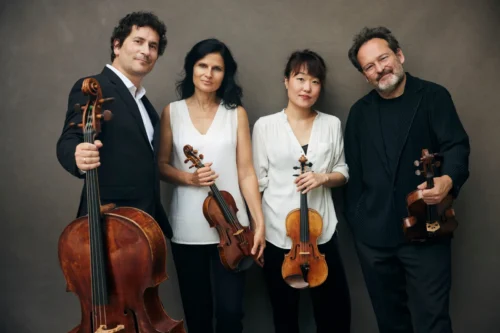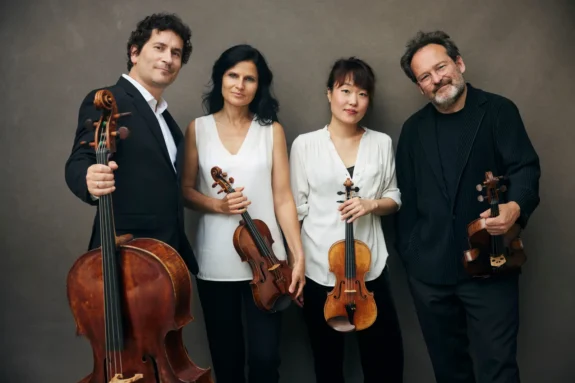 United Kingdom Mozart: Belcea Quartet (Corina Belcea [violin], Suyeon Kang [violin], Krzysztof Chorzelski [viola], Antoine Lederlin [cello]) and Tabea Zimmermann (viola). Wigmore Hall, London, 18.10.2024. (CSa)
United Kingdom Mozart: Belcea Quartet (Corina Belcea [violin], Suyeon Kang [violin], Krzysztof Chorzelski [viola], Antoine Lederlin [cello]) and Tabea Zimmermann (viola). Wigmore Hall, London, 18.10.2024. (CSa)

Mozart – String Quintet in C minor, K406; String Quintet in C major, K515
It was a wet autumn morning in the mid ‘70’s when I first encountered the six string quintets by Mozart. I was a young barrister briefed to defend a hapless client at Aylesbury Assizes, and as ever, running late. Turning on the radio of my ancient Citroën 2CV to relieve the tension of the journey, I was immediately captivated by a recording of Quintet No.3 in C major. So much so that I missed my turning on the A41, hit a traffic jam and showed 45 minutes late. After providing a faltering and entirely truthful explanation for my unpunctuality, the frosty judge asked me which quintet I had heard and wanted to know who had been playing it. ‘K515 M’lud’ I stammered, ‘the Amadeus and Cecil Aronowitz.’ ‘Ah, a very fine recording, Mr Sallon’ said the judge approvingly, a thin smile on his face, ‘but try not to let it happen again.’
These recordings were made when the Amadeus Quartet and Aronowitz were considered amongst the greatest exponents of late eighteenth and early nineteenth century chamber music. Grounded in the pre-war central European tradition – dulcet in tone, effortlessly lyrical and classically balanced – their readings might be considered sweeter and perhaps more sentimental than today’s emotionally charged interpretations.
This was certainly the case in an intense, highly expressive performance of two of three string quintets written by Mozart in the Spring of 1787, by the celebrated Belcea Quartet and violist Tabea Zimmermann at London’s Wigmore Hall. They started with String Quintet in C minor, K406, which Mozart had adapted from an earlier wind serenade when he was at the height of his creative powers. The darkness and austerity of this work was immediately revealed in the raw opening unison notes and the poignant developing melodies of the first movement Allegro. Corina Belcea (first violin) and her colleagues gave an unflinching account which left behind the old and classical order of Haydn’s musical world and looked instead toward the spiritual turmoil of Schubert and Beethoven. Weaving skilfully between gently melodic and stormy passages, the players created an intricate and constantly shifting Romantic drama. The lilting Andante, with its off-balance stresses and deeply affecting harmonic clashes, was all bittersweet tenderness, while the rigorous contrapuntal rhythms of the Menuetto in canone, executed here with severe beauty, did not conform in any way to the light-hearted courtly dance suggested by the movement’s title. The final Allegro in which the original horn parts were re-written for violas, alternated deliciously between playfulness and introspective solemnity.
One work occupied the second half: the String Quintet in C major, K515. Majestic and considerably more optimistic than the previous work, it was a good choice. Opening with a pulsing conversation between Antoine Lederlin’s cello, and Belcea’s violin, one instrument asked questions which were answered by the other with sweet simplicity, before roles were wittily reversed. The Menuetto: Allegretto, in the wrong hands, can be a coarsely rustic affair, but played by these matchless musicians proved to be graceful and elegant. It led to a hauntingly beautiful Andante followed by a gloriously joyous Molto Allegro finale.
Although greeted by thunderous applause, the ensemble needed little encouragement to offer an encore – a richly textured and utterly gorgeous account of the Adagio from Brahms’s String Quintet in G, Op.111. It was a tender and generous way to bid the audience ‘good night’.
Chris Sallon
